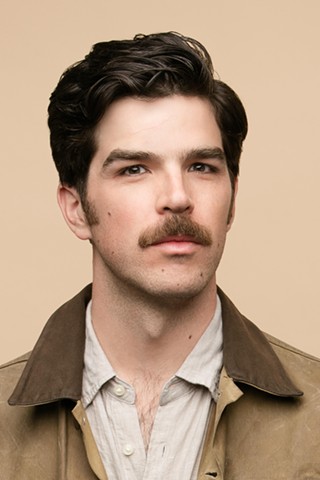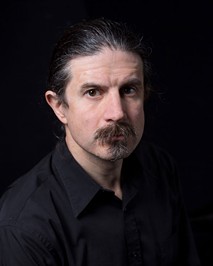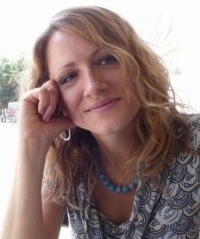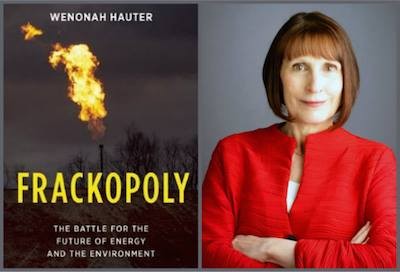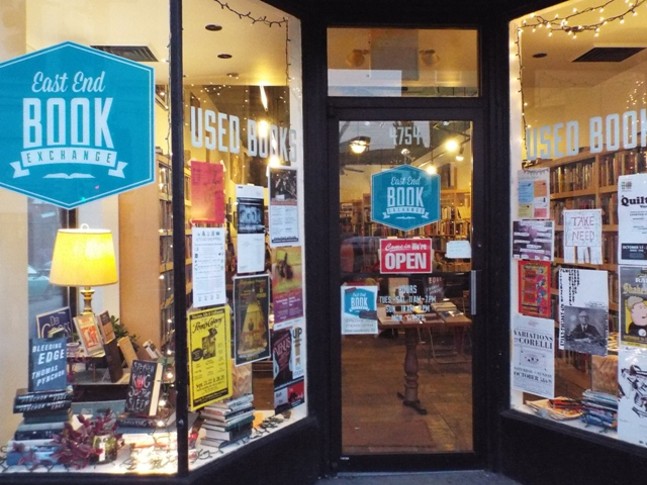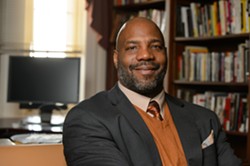Friday, August 31, 2018
Sara Bir is nosy. She peeks into backyards, deep corners of the forest, and Walmart parking lots.
She’s a forager with an eye for forgotten fruit, abundant harvests, and nature’s strangest offerings.
Bir is the author of The Fruit Forager’s Companion, a book filled with recipes, tips, and tricks for the everyday forager. On Sept. 1, she will team up with White Whale Bookstore in Bloomfield and a fellow fruit-lover Andrew Moore for a book signing and discussion.
Tags: Sara Bir , White Whale Bookstore , foraging , cookbook , pawpaw , Marietta , Ohio , Bloomfield , Pittsburgh , Southwestern Pennsylvania , Image
Friday, February 16, 2018
No one understands the difference between immigration myths and facts better than author Francisco Cantú. Cantú worked as a U.S. Customs and Border Protection agent from 2008 to 2012. He patrolled the U.S.-Mexico border, and also grew up near the border while his mother worked at National Parks in the Southwest.
He wrote a memoir about his experience as a border-patrol agent called The Line Becomes a River. Cantú studied international relations in college, and he describes in the book how he wanted to join the border patrol so he could experience the actual border, instead of just studying theory in the classroom.
The book has received praise from critics across the country for its authentic portrayal of law-enforcement officers and undocumented immigrants. Cantú will be at the City of Asylum bookstore at Alphabet City, in the North Side, on Feb. 17 for a free reading of his new book.
Tags: Francisco Cantú , Pittsburgh , City of Asylum , Alphabet City Center , North Side , U.S. Customs and Border Protection , Migration Policy Institute , undocumented immigrant , U.S.-Mexico border , Image
Thursday, February 1, 2018
I'm heading to 90.5 WESA, where I'll be arts and culture reporter.
I'd like to thank all my colleagues over the years, our readers, and all the people and institutions I've written about, for making it such a memorable ride. It all started back in 1997, when nobody at CP had email yet and the whole office shared one dial-up internet connection.
If you'll indulge me, to cap things off, here are some of my own favorite articles from over the years, culled from some of the nearly 1,100 issues I've been part of here.
Many are long-form pieces, from the days when we had the time and newsprint to run such articles weekly; they were a challenge to report and write, but looking back, they're some of the most worthwhile things I did.
All but one of these 18 articles are from 2003 or later, because that's as far back as CP's online archive goes. (Too bad; I have some faves from the early years, too.)
In chronological order:
This 2002 piece on motorcycle road-racer Keith Reed is not in our archive, but was cut-and-pasted by an enterprising message-boarder. (I think a few drop-caps are missing, but like some text magically salvaged from the library of Alexandria, it's mostly there.)
An April 2004 profile of falconer and bird-of-prey expert Earl Schriver, whose life's mission is to disabuse the public of what he called "the Bambi complex."
Big ideas are fun. Here's "Muse You Can Use," a May 2005 piece on what art's good for or whether it needs to be good for anything at all.
Tags: Keith Reed , motorcycle racing , Earl Schriver , T. Foley , Terrance Hayes , Kevin Tucker , anarcho-primitivism , Bill Dorsey , endocrine disrupters , Stephen Foster , Bobby Porter , We Are Nature , Charles Eisenstein , fake news , Image
Wednesday, March 15, 2017
University of California, Riverside Professor Jane Ward visits Pitt tomorrow to discuss her highly controversial book Not Gay: Sex Between Straight White Men.
Almost 70 years after Alfred Kinsey and his Institute gave us the Kinsey Scale, Ward’s 2015 book sheds light on how straight-identified men explain the reality of their sexual fluidity. It turns out that for a lot of the men Ward interviewed, it’s not "gay" if the gay sex you’re having reaffirms rather than challenges your masculine identity.
Tomorrow, Ward gives a lecture on her research, titled "The Tragedy of Heterosexuality," from 4-5 p.m. in the Cathedral of Learning. The lecture is presented by Pitt's Gender and Sexuality Program and is free and open to the public.
The talk takes place in Room 602. The Cathedral of Learning is located at 4200 Fifth Ave., Oakland.
Tags: Jane Ward , University of Pittsburgh , Not Gay: Sex between Straight White Men , Image
Monday, August 8, 2016
Count among them Jeffrey Toobin, staff writer at the New Yorker and legal analyst for CNN. His new book Heiress: The Wild Saga of the Kidnapping, Crimes and Trial of Patty Hearst (Doubleday) chronicles the kidnapping in the context of a very troubled decade in a very troubled state.
Toobin will discuss the book and its story tonight at Carnegie Library Lecture Hall. CP called him to discuss the book a few hours prior.
You were a teenager when the story of Patty Hearst’s kidnapping broke. Do you remember your response to the story at the time?
To be honest, I have very little first-hand memory. I was aware of it in the way that a 13-year-old is aware of big issues in the news. I was kind of a Watergate junkie as a kid, so I knew more about Watergate than I did about the Hearst case.
There was this weird thing where it came out that one of the places she was held briefly, or one of the places she stayed briefly, was on my block in Manhattan on West 90th Street, and I remember joking with my parents about that — “Did you see her?”
That’s funny, I was just talking to a coworker who grew up in San Francisco and had hoped as a kid to be the one to find Hearst.
Speaking of that time period, the immediate aftermath of her kidnapping I feel gets lost in the madness and oddity of the whole story. We don’t hear much about the very beginning of the story. Can you talk about those first few weeks after her kidnapping?
Well, I think it’s important to say that this was a horrible and terrible experience, to be kidnapped. I don’t think we should minimize the horror of what she went through. To be thrown in a car trunk by people she knew to be murderers, who had killed Marcus Foster, the Oakland school superintendent, and bragged about it, was terrifying. But in the bizarre way of how this story unfolded, things changed over time.
When did you become interested in writing about this story?
It was really only a couple of years ago. I had not really thought about it. But then I wrote a story for the New Yorker about a gang that took over a jail in Baltimore. I got interested in the history of the gang, which is called the Black Guerrilla Family. It was founded by George Jackson, the famous prisoner in Soledad prison. I discovered that the prisons in the ‘70s, especially in California, were sort of hotbeds of political activity, and it turned out that the Symbionese Liberation Army came out of the same world. And that’s what lead me back to the Patty Hearst story, through the New Yorker story I wrote.
You’ve also written in depth about the O.J Simpson case with The Run Of His Life: The People v. O.J. Simpson (which was adapted for television on FX). Both stories feel emblematic of their decade. Hearst’s in the context of Watergate, Vietnam, domestic terrorism, classism in the 1970s and Simpson’s in celebrity, television, race, and voyeurism in the '90s. Did you run into other parallels between the two stories?
What was particularly striking to me was just how violent and dangerous things were in the '70s. The unbelievable amount of crime, political crime, a thousand bombings a year — just think about that idea of a thousand political bombings a year — which was going on in the '70s. The nature of criminal spectacle certainly was a parallel between Patty Hearst and O.J. But the magnitude of public attention was certainly greater in the '90s because there were just so many media outlets at the time.
What would you say is the biggest misconception about Patty Hearst in the general public?
Well, that Patty Hearst was coerced to commit one bank robbery, when in fact she committed an extraordinary number of crimes over the course of nearly a year and half. Three bank robberies, including one where a woman died, shooting up a street in Los Angeles, setting off bombs in Northern California. This was not a single act she was coerced to commit — this was a crime wave she was an intimate part of.
I imagine it’s because of that iconic photograph of her at the bank.
The photo obviously is the defining image of the experience, but also I think she did a pretty good job of convincing people that this was sort of a one-off thing.
Why do you think this story resonates so well with the general public?
Because it’s a mystery. I think people identify with the mystery. The question of whether a kidnap victim can turn into a fellow criminal with her kidnappers is a very compelling question and I think people remain fascinated by it, and often react very differently.
My purpose in telling the story is not so much to advocate for one view of her or another, but to lay out the full story in all its strangeness and that, to me, is more interesting than the psychobabble you often hear about the case, about brainwashing, about Stockholm syndrome, terms that are more journalistic than medical.
What’s life for Patty Hearst been like since this story took place?
Perhaps the most bizarre and interesting thing of all about Patty Hearst’s life after the kidnapping is that she has led the life for which she was destined. She is a homemaker, a socialite, a rich woman in the suburbs, and a mother, a grandmother, with a few quirky interests like being in John Waters movies a couple times. But basically she has led the life for which she was destined, notwithstanding this extremely bizarre interlude.
Tags: Jeffrey Toobin , Patty Hearst , Image
Thursday, June 30, 2016
The books explores government policies that have kept Chicago segregated by race. Moore argues that race (rather than class) is the defining factor in inequality and a pervasive feature of life there.
The critically acclaimed book should have resonance nationally, and perhaps especially in Pittsburgh, where segregation is rife and where many say an influx of new development (hello, East Liberty!) has left many longtime residents, in particular African Americans, without affordable housing.
“While mayors Richard M. Daley and Rahm Emanuel have touted Chicago as a ‘world-class city,’ it remains one of the most segregated cities in America,” according to press materials for The South Side. “And while it would be easy to think of a city with a billion-dollar park, Michelin-rated restaurants, waterfront views, world-class shopping, and a thriving theater scene as a model for other metropolitan areas, underneath the shiny façade lurks the horrible reality of deeply-rooted and destructive racial segregation.”
Moore grew up in Chicago’s South Side and is the South Side bureau reporter for WBEZ-FM, Chicago’s NPR station. In the past, she’s worked for Detroit News, St. Paul Pioneer Press and the Associated Press in Jerusalem. Her journalism has also been published in national outlets including Essence and In These Times.
Moore will be at Barnes & Noble for an informal discussion from 7-9 p.m. tomorrow. The event is free.
The store is located at 100 West Bridge St.
Tags: Natalie Moore , The South Side: A Portrait of Chicago and American Segregation , Barnes & Noble , Waterfront , Image
Friday, June 17, 2016
Wenonah Hauter has been entrenched in policy for a long time. As the founder and current director of the advocacy group Food & Water Watch, she helped organize to ban fracking in New York. Since 1989, she served in the upper echelons of three environmental-advocacy organizations, and now she's debuting her second book on regulations that create industry monopolies. In Frackopoly: The Battle for the Future of Energy and the Environment, Hauter walks readers through the history of policies governing the industry and introduces various players that created fracking's ubiquity today. (Her first book was titled Foodopoly and looked at big industry and food policy.)
Fracking, or hydraulic fracturing, is the practice of injecting a mixture of water, sand and chemicals deep underground at high pressure to release oil or gas trapped in rock formations there.
City Paper caught up with Hauter by phone before she speaks in Pittsburgh tonight in a free event at the Pittsburgh Theological Seminary.
Why did you decide to write this book?
I've worked on energy issues for a long time and have been interested in how we ended up with the energy system that we have today, so I decided to write a book that both looks at the history of the oil and gas industry and the politics that have led us here today. I especially highlighted the grassroots movement that’s emerged to ban fracking.
In Western Pennsylvania, people often talk about fracking in the Marcellus Shale because we live right on top of it. But you went around the world and the country and looked at fracking in other places. Can you talk about that?
Fracking was developed in the U.S. and was transported to other places in the world, even through our State Department, which promoted fracking. First [fracking] was for energy independence here in the U.S., and then when the price of oil and gas fell, it was about working with allies around the world to stabilize prices.
But one of the things I learned when writing Frackopoly was that from the very earliest days of the oil and gas industry to the monopoly that John D. Rockefeller had, the oil and gas industry has had constant booms and busts. Overproduction is just the story. ... In our view, this was just irresponsible to frack at such a rapid rate. It’s a number of technologies that come together that make it possible to go deep underground or deep under the ocean to loosen up oil or gas. One of the misconceptions is [that] fracking is mostly for natural gas, but over the last several years fracking has been used 80 percent [of the time] for oil.
You mentioned that fracking was developed here and then exported all over the world. This has actually come up in the presidential campaign. Did you get into how presumptive Democratic nominee Hillary Clinton was involved in advocating for fracking in other countries as Secretary of State?
Yes, I do mention it in the global section, [but the book] was finalized earlier this year, so I haven’t talked a lot about the presidential election. But I did talk about the secretary’s term as Secretary of State, and she definitely sent representatives and, in some cases visited herself, to places like Bulgaria and Romania. Bulgaria’s congress banned fracking, and the State Department was very anxious to see that policy undone. We often see this with a number of industries where the State Department is actually used as an instrument to benefit U.S. corporations.
What are the examples of public policies across the nation that paved the way for fracking's popularity?
There are a lot of ways that environmental regulations have been manipulated to help the oil and gas industry over the last several decades. But I also wanted to talk about some of the other policies that aren’t on those people’s radars. The price of natural gas was deregulated beginning in 1978. For decades before that, the price of gas was determined by the Federal Power Commission, [which] also determined if a new pipeline needed to be built, and [producers] were regulated on cost of production and transporting the gas. [Former President] Jimmy Carter create[d] the Department of Energy and then as an agency inside of [it], the Federal Energy Regulatory Commission. So you can see this is really technical stuff. This was followed up by the deregulation of electricity markets. …
And then there were other major things, the Energy Policy Act of 2005. We often hear about the Halliburton Loophole, which exempted fracking chemicals from disclosure or regulation under the Safe Drinking Water Act. What we don’t often hear about is FERC’s power being expanded so they could condemn land and force people to allow pipelines or transmission lines to be built. And then one very important other thing that happened [in 2005], the Public Utility Holding Company Act of 1935 was repealed. That was legislation directed at making electric and gas utilities behave responsibly because a big reason for the 1929 crash was terrible irresponsible speculation, the kind of speculation that we’ve recently seen in 2008 and 2009 that crashed our economy. When that was repealed, it allowed electric utilities to become giant.
It sounds like you walk readers through a trail of legislation that led us to today.
What I do in Frackopoly, I go through the personalities because this is wonky stuff. I talk about who they were, who made this happen. I talk about some of the recent personalities, people like the late [Chesapeake Energy executive] Aubrey McClendon, who just died very mysteriously, and a number of other people. And I was journalistic in doing it. Obviously I have a political agenda. I don’t pretend that I don’t.
Are you a journalist by training?
No I’m an anthropologist, but I’ve been writing for years. I like the facts to speak for themselves. Especially on this issue, you don’t need a lot of rhetoric. Just look at the facts. I really meticulously footnoted this book because I expect it will be controversial.
Hauter speaks at 6:30 p.m. tonight at the Pittsburgh Theological Seminary, 616 N. Highland Ave., in East Liberty. Admission is free. Find more info here.
Tags: Wenonah Hauter , Frackopoly , Pittsburgh , fracking , books , Pittsburgh Theological Seminary , Food & Water Watch , Image
Monday, March 14, 2016
Arlan Hess, who purchased the name, inventory and some of the shelving from the South Side’s shuttered City Books, is reopening it tomorrow on the North Side.
The Galveston Avenue storefront (right next to the Modern Café) will also have a modest grand opening celebration this Saturday, during its regular hours of noon-5 p.m. (Cupcakes are promised.)
Hess, of Mount Lebanon, for years taught literature and creative writing at Washington & Jefferson College, but was ready for a change. When she saw that City Books was closing, in late 2014, after a three-decade run on East Carson Street, she “jumped at it.”
Hess says she purchased City Books’ stock – some 20,000 books – this past April from founder and owner Ed Gelblum. (Gelblum died the following month.)
Her final month teaching was May. When a plan to reopen the store in Brookline fell through, she found the Galveston Avenue space on Craigslist. And she liked Allegheny West, with its proximity to the Mexican War Streets, CCAC and City of Asylum/Pittsburgh (which actually plans to open its own bookstore in its new Alphabet City space, on North Avenue, in the near future).
Reached by phone today, Hess says that she and her husband had been working seven days a week to ready the store for tomorrow’s soft open. It might well be Pittsburgh's lone used bookstore north of the Allegheny.
The original City Books was for years a cultural anchor on the South Side. In the 1980s and '90s, it was known for hosting literary readings and live music as well as for its jam-packed two floors of books. The new City Books is rather more compact. At 600 square feet, says Hess, “It’s a little teeny pocket bookstore.” The shelves have room for about 4,000 books, she says. (The rest are in storage.)
But many customers will find the shop more user-friendly. Hess says she has reconfigured the selection, paring down Gelblum’s extensive philosophy offerings, for instance, and adding children’s and young-adult books.
Though new to the book business, she’s been studying it. She plans to revive the store’s online presence (a big part of the book trade nowadays, even for indie shops) and to host small literary readings.
City Books is located at 908 Galveston Ave. It will be open seven days a week, from 11 a.m.-6 p.m. Tuesday through Friday, and noon-5 p.m. Saturday and Sunday.
Learn more here.
Tags: City Books , North Side , Allegheny West , Arlan Hess , Image
Friday, March 11, 2016
Owner and founder Lesley Rains has announced that her five-year-old store in Bloomfield is up for sale. But she emphasizes that she’s not selling because it’s doing poorly.
“The store is fine,” she told CP in an interview today. “We’re not in debt. We’re profitable.” She’s also just signed a new three-year lease for the space on Liberty Avenue.
However, she does feel like the store, which stocks both new and used titles, could do better were it owned by someone with the investment wherewithal and, frankly, the energy to take it further. That person, she says, is not her.
“I’ve kind of plateaued … and it’s time to find some new energy and some new vision.”
If the response to her sales announcement is any indication, those things might be out there: Rains tells CP she was getting calls “within hours” of making the announcement, and as of this afternoon had already had four meetings with interested parties, with four more scheduled.
That level of interest speaks partly to the surprising local resurgence of indie bookstores (which this week included the announcement of the re-opening, in a new location and under new management, of the venerable City Books, more on which in a future post).
But it also reflects EEBX’s status as a popular venue for readings and other events by both local and touring writers. Rains said that function has been “indispensable," both in terms of marketing the store and in boosting sales. Sometimes, she says, a reading will double or triple her sales on a given day.
Rains is still seeking potential buyers; in her March 3 announcement, she said she would “entertain serious offers from business-savvy booklovers who, ideally, will stay true to the store's identity as a literary community spot.”
Interested parties should contact her at [email protected] or call 412-224-2847.
In the interim, the store will operate as usual.
Tags: East End Book Exchange , Lesley Rains , Bloomfield , Image
Wednesday, February 10, 2016
The associate professor of history at the University of Connecticut (and director of the Africana Studies Institute there) is a staff writer for The New Yorker, where his articles have included “The Anger in Ferguson,” “Murders in Charleston” and “What We Talk About When We Talk About Reparations.”
Last year, Cobb won the Sidney Hillman Prize for Opinion & Analysis Journalism. The jury wrote, in part, “Cobb met the challenge of describing the turmoil in Ferguson in a way that cut through the frantic chaos of 'breaking news' and deepened readers' understanding of what they were seeing, hearing, and feeling. Ferguson was not an aberration, he showed, but a microcosm of race relations in the United States — organically connected to the complicated legacy of segregation and the unpaid debts of slavery itself.”
Cobb's books include Substance of Hope: Barack Obama and the Paradox of Progress and To the Break of Dawn: A Freestyle on the Hip Hop Aesthetic.
Cobb’s talk at CMU is titled “The Half Life of Freedom: Race & Justice in American Today.”
The talk, which is free, begins at 4:30 p.m. Thu., Feb. 11, in Porter Hall 100. (Here's an interactive map of CMU's campus.)
Tags: Jelani Cobb , Carnegie Mellon , Race and Justice in America , Image



